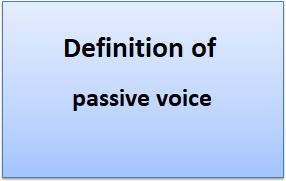Passive voice:
The passive voice is the main element of grammar The subject of a sentence is not the actor but the recipient of the action. In layman’s terms, the subject is the recipient of the verb. For example, in the sentence “The book is read by him in one hour,” the subject is “the book” and the verb is “is read.” The actor in this sentence is “him.”
Passive voice is the use of verbs and nouns not directly related to action. rather than define something or someone as a result of a previous action. For example, say “Sarah got another promotion” instead of “Sarah was promoted again.” A passive voice is easy to spot if you know what to look for.
Some basic rules apply while using the passive voice. First, the verb has to be in the correct form. Second, the subject should be in the correct case. And third, the sentence is constructed correctly.
The “Be” verb has eight forms Be, is, are, am, was were been, being, if the sentence consists of any one form of a verb and the second verb appears with a past participle of the third form, that sentence has to be considered passive voice.
Subject + verb + to be + Past participle
Here are a few examples of the passive voice in action:
- The ball was thrown by the boy.
2. The lamp was knocked over by the cat.
3. The window was broken by the wind.
4. A letter is written
5. Flowers are being plucked
6. They were punished
7. The enemy has been defeated
8. Six burgers must have been eaten by a boy
Burgers (subject) have been eaten (verb)
9. The letter was sent by john
The letter (subject) was sent (verb)
Passive voice is often used in academic writing, especially in disciplines such as science and engineering. This is because it can make complex ideas and processes easier to understand. For example, “The cricket match is being won by our team” is in the passive voice. This sentence is easy to understand because it is clear who wins the cricket match. If the sentence were in the active voice (“our team is winning the cricket match”), it would be less clear who or what was responsible for the cricket match winning.
Forming the passive voice:
The passive voice in English is composed of two elements:
the appropriate form of the verb ‘to be’ + past participle
| Affirmative | Negative | Interrogative | Negative interrogative |
|---|---|---|---|
| The building was built in 1890. | The building wasn’t built in 1890. | Was the building built in 1890? | Wasn’t the building built in 1890? |
| These buildings were built in 1890. | These buildings weren’t built in 1890. | Were these buildings built in 1890? | Weren’t these buildings built in 1890? |
Passive voice with infinitives:
The infinitive passive voice is used after modal verbs and other verbs normally followed by an infinitive.
Examples
- You have to be tested on your technical work.
- David might be promoted in the coming time.
- My family wants to be invited to the party.
- He expects to be surprised on my birthday.

